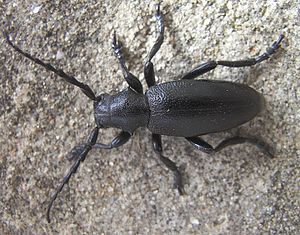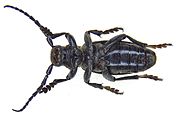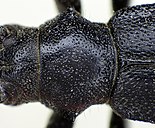Dorcadion aethiops
| Dorcadion aethiops | ||||||||||
|---|---|---|---|---|---|---|---|---|---|---|

Dorcadion aethiops |
||||||||||
| Systematics | ||||||||||
|
||||||||||
| Scientific name | ||||||||||
| Dorcadion aethiops | ||||||||||
| ( Scopoli , 1763) |
Dorcadion aethiops , synonymous with Carinatodorcadion aethiops , is a beetle from the family of the longhorn beetle and the subfamily Lamiinae . The animal, which penetrates from the south-east into Central Europe, is one of the earth bucks that live on the ground.
Notes on the name
The species was first described by Scopoli in 1763 as Cerambyx aethiops . Scopoli begins the diagnosis of the species with: Totus niger, ... ( lat. Completely black, ..). This explains the species name "aethiops" (from ancient Greek αιθίοψ aithíops Brandgesicht, Mohr,) "Aethiops" is used in scientific nomenclature for black animals and gives no indication of their origin. The German name "Ethiopian Erdbock", which is occasionally used, is therefore misleading.
The generic name "Dorcadion" (from ancient Greek δορκάς dorkas, gazelle δορκάδιον dorkádion, goat) expresses that it is a question of smaller longhorn beetles. This does not apply to Dorcadion aethiops . Carinatodorcadion is a Dorcadion with a keel (lat.carina = keel). Depending on the author, Carinatodorcadion is classified as a genus or traditionally as a subgenus of Dorcadion with a different number of species.
Characteristics of the beetle
The body is black. It is elongated oval and reaches a length of 12 to 26 millimeters.
The head is inclined vertically downwards to the body axis, the mouthparts point downwards. The front edge of the head shield is drawn forward, the base of the mandibles lies in a lower level. Viewed from the front, the head shield is cut off just above the upper lip (visible in Fig. 4 at full magnification). The eleven-limbed antennae are long, but only reach about the middle of the wing in both sexes . The first antenna element is very robust, the second, like almost all longhorn beetles, is short and is reminiscent of the shape of an acorn fruit cup. The third antenna element is shorter than the first (Fig. 3). The length ratio of the first to the third antenna segment is an important characteristic for distinguishing the genus. The following antenna segments become increasingly smaller, they are all slightly knotty at the end (Fig. 5). The kidney-shaped compound eyes encompass the antenna base from behind. At the apex, the inner edges of the eyes are closer together than the inner edges of the antennae bases (on the left in Fig. 3, on the left in Fig. 3 and recognizable in the taxo image).
The pronotum is slightly wider than it is long and drawn out into a pointed hump on the sides. The longitudinal center line is sunk at most, in contrast to the Brown Red Erdbock ( Dorcadion fulvum ) not clearly deepened like a channel (Fig. 6).
The elytra are glossy black, rarely a little brownish. There is no white tomentation on either the wing cover seam or the edges of the wing cover . The species is unable to fly, the hind wings have receded, the wing wings have grown together at the seam.
The legs are very sturdy. The five-limbed tarsi appear to be only four-limbed (pseudotetrameric), as the very small fourth tarsal is hidden between the lobes of the third tarsal.
 Fig. 1: Pairing, side view Fig. 2: Underside Fig. 3: Sensor links one to three black: lengths of the three links   |
 Fig. 4: Front view Fig. 5: Sensor  Fig. 6: pronotum left head, right wing covers |
biology
The species is very warm and drought-loving (xerothermophil) and occurs in open areas. The adults eat leaves and roots. The larvae eat grass roots. They need a year to develop. Pupation takes place in the earth. The beetles appear in spring and move slowly.
distribution
The range of the species is very compact and limited to Southeast Europe and the Ukraine, Poland , Germany , Switzerland and Italy are already outside the range, in Albania and Greece the occurrence is questionable.
literature
- Heinz joy, Karl Wilhelm Harde, Gustav Adolf Lohse (ed.): The beetles of Central Europe . tape 9 . Cerambycidae Chrysomelidae . Spektrum Akademischer Verlag, Munich 1999, ISBN 3-8274-0683-8 (first edition: Goecke & Evers, Krefeld 1966).
- Adolf Horion: Faunistics of the Central European Beetles, Bd. XII . Überlingen-Bodensee 1974
- Klaus Koch : The Beetles of Central Europe . Ed .: Heinz Freude . tape 3 : ecology . Goecke & Evers, Krefeld 1992, ISBN 3-87263-042-3 .
Individual evidence
- ↑ JA Scopoli: Entomologia Carniolica exhibens insecta Carnioliæ indigena et distributa in ordines, genera, species, varietates. Methodo Linnæana Vindobonae 1763 Original description on p.91: 53 as No. 169 at GDZ
- ↑ Sigmund Schenkling: Explanation of the scientific beetle names (species)
- ↑ Sigmund Schenkling: Explanation of the scientific beetle names (genus)
- ↑ Carinatodorcadion at Fauna Europaea. Retrieved February 19, 2013
- ↑ Carinadorcadion at BioLib
- ↑ Carinatodorcadion aethiops at Fauna Europaea. Retrieved December 12, 2010
